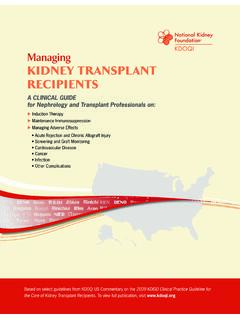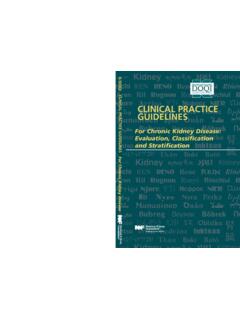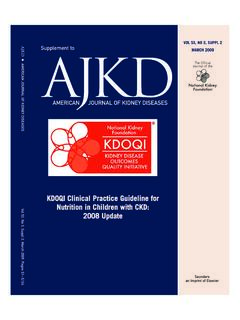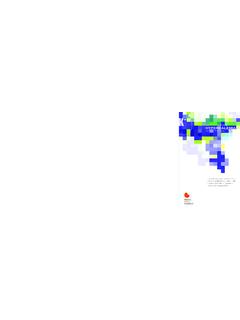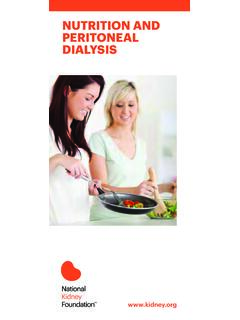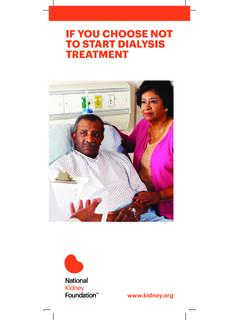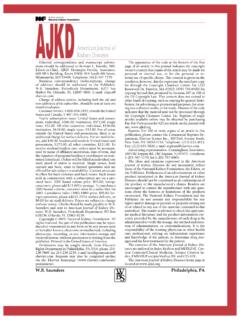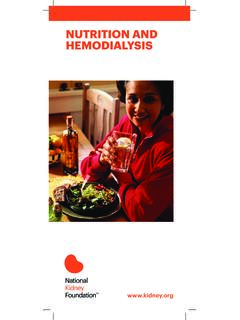Transcription of Best Practices in Managing Table 3. 6 HYPERKALEMIA
1 TREATMENT OF HYPERKALEMIA IN CKDREFERENCES Table East 33rd StreetNew York, NY publication has been sponsored and developed in collaboration with Relypsa, Inc. 2016 National Kidney Foundation, Inc. 02-10-7259_LBGK + Best Practices in Managingin Chronic Kidney DiseaseHYPERKALEMIA The steps to address HYPERKALEMIA include stabilization, redistribution, and excretion/removal of of interventions used for acute or chronic treatment of hyperkalemia6 TreatmentRoute of Onset/ mmol of calcium, corresponding to 10 ml CaCl (10%)* or 30 ml calcium gluconate (10%) solutionsIntravenous (acute)
2 1-3 min30-60 minMembrane potential stabilization Does not affect serum potassium level Effect measured by normalization of electrocardiographic changes Dose can be repeated if no effects noted Caution advised in patients receiving digoxin50-250 ml hypertonic saline (3-5%)**Intravenous (acute)5-10 min~2 hMembrane potential stabilization Efficacy only in hyponatremic patients50-100 mmol sodium bicarbonateIntravenous (acute) or oral (chronic)5-10 min~2 hRedistribution Sodium may worsen pre-existing hypertension and heart failure Efficacy questioned for acute treatment of patients on dialysis10 units of regular insulinIntravenous (acute)30 min4-6 hRedistribution Administer with 50 g of glucose intravenously to prevent hypoglycemia 2-receptor agonists.
3 10-20 mg aerosol (nebulized) or in 100ml of 5% dextrose in water (intravenous)Intravenous or nebulized (both acute)30 min2-4 hRedistribution Effect independent of insulin and aldosterone Caution in patients with known coronary artery disease40 mg furosemide or equivalent dose of other loop diuretic. Higher doses may be needed in patients with advanced CKDI ntravenous (acute) or oral (chronic)VariesUntil diuresis present or longerExcretion Loop diuretics for acute intervention Loop or thiazide diuretics for chronic management.
4 Loop diuretic for GFR <40 ml/ m2 15 May not be effective in patients with reduced GFRF ludrocortisone acetate mg (up to mg daily)Oral (chronic)NAExcretion In patients with aldosterone deficiency, large doses might be needed to effectively lower potassium levels Sodium retention, edema, and hypertension might occur, and acceleration of kidney and cardiovascular diseaseCation exchange resins Sodium polystyrene sulfonate25-50 gOral or rectal (either acute or chronic), with or without sorbitol1-2 h 4-6 hExcretion Cases of intestinal necrosis, which may be fatal, and other serious GI adverse events have been reported16 May cause hypokalemia and electrolyte disturbances16 Cannot be used in medical emergencies16 Caution in patients with heart failure due to sodium load16 Cation exchange polymer Patiromer , , or g Oral (either acute or chronic)7 h~48 hExcretion Binds with many other oral medications (in vitro binding studies)
5 , separate the dosing of other oral medications by at least 6 hours 17 ** Should not be used as an emergency treatment for life-threatening HYPERKALEMIA because of its delayed onset of action17 May result in hypokalemia or hypomagnesemia17 DialysisHemodialysis (acute or chronic);Peritoneal dialysis (chronic)Within minutesUntil end of dialysis or longer**Removal Effects of dialysis on serum sodium, bicarbonate, calcium and/or magnesium levels can affect results For chronic hemodialysis, missed treatments and 2-day interdialytic interval may have a negative impact on Tran HA.
6 Extreme Med J. 2005;98 Gumz ML, Rabinowitz L, Wingo CS. An integrated view of potassium Engl J Med. 2015;373 Alvo M, Warnock DG. J Med. 1984;141:666-671. 4. Einhorn LM, Zhan M, Hsu VD, et al. The frequency ofhyperkalemia and its significance in chronic kidney disease. Arch Intern Med. 2009;169:1156-1162. 5. Jain N, Kotla S, Little BB, et al. Predictors ofhyperkalemia and death in patients with cardiac and renal disease. Am J Cardiol. 2012;109 Kovesdy CP. Management of hyperkalaemiain chronic kidney disease.
7 Nat Rev Nephrol. 2014;10 Sarafidis PA, Blacklock R, Wood E, et al. Prevalence and factors associated with HYPERKALEMIA in predialysis patients followed ina low-clearance clinic. Clin J Am Soc Nephrol. 2012;7 Turgut F, Balogun RA, Abdel-Rahman EM. Renin-angiotensin-aldosterone system blockade effects on the kidney in the elderly:benefits and limitations. Clin J Am Soc Nephrol. 2010;5 Xie X, Liu Y, Perkovic V, et al. Renin-angiotensin system inhibitors and kidney and cardiovascular outcomes in patients with CKD: a Bayesian Network meta-analysis of randomized clinical trials [Epub ahead of printNovember 17 2015].
8 Am J Kidney Dis. 2015. 10. Kidney Disease: Improving Global Outcomes( kdigo ) CKD Work Group. kdigo 2012 clinical practice guideline for the evaluation and management of chronic kidney disease. Kidney Int Suppls. 2013;3 Inker LA, Astor BC, Fox CH, et al. KDOQI on the 2012 kdigo clinical practice guideline for the evaluation and management of CKD. Am J Kidney Dis. May 2014;63(5) Mercier K, Smith H, Biederman J. Renin-angiotensin-aldosterone system inhibition: overview of the therapeutic use of angiotensin-converting enzyme inhibitors, angiotensin receptor blockers,mineralocorticoid receptor antagonists, and direct renin inhibitors.
9 Prim Care. 2014;41 Vassalotti JA, Centor R, Turner BJ, et al; Kidney Disease Outcomes Quality Initiative (KDOQI). A practical approach to detection and management of chronic kidney disease for the primary care clinician [Epub ahead ofprint September 18 2015]. Am J Med. 2015. 14. Lehnhardt A, Kemper MJ. Pathogenesis,diagnosis, and management of HYPERKALEMIA . Pediatr Nephrol. March 2011;26 Sarafidis PA, Georgianos PI, Bakris in treatment of hyperkalemiain chronic kidney disease. Expert Opin Pharmacother.
10 2015;16 Food and Drug Administration (FDA). Kayexalate. Updated December 2010. Accessed December 22 Food and Drug Administration (FDA). FDAapproves new drug to treat HYPERKALEMIA . Published October 22 2015. Accessed November 24 2015. HYPERKALEMIA in Chronic Kidney Disease (CKD) Treatment with RAAS Inhibitors (RAASi) in CKD Diagnosis and Evaluation of HYPERKALEMIA Treatment of HYPERKALEMIA in CKD*CaCl is caustic and could damage peripheral veins. **Limited data available from clinical studies.
